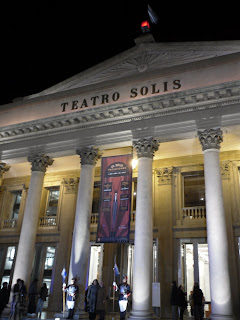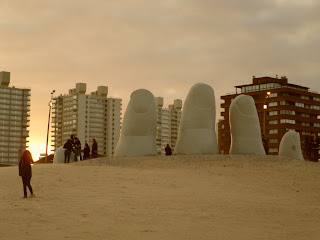My responsibilities at San Fernando Rey have been varied: introducing poems to phonetics classes, helping with grammar lessons on adjectives, presenting on topics that intertwine political, social, and historical issues of national and international relevance in the United States, teaching construction of the future tense, conducting self-reflection exercises for students to think about how they communicate, reading newspaper articles....and the list goes on and on. However, I am prodded at least once a week with the gentle reminder that while I teach at essentially the equivalent of a community college in the United States, my students have not received the same training in elementary and high school that I might expect from a similar student in the United States. These reminders come often in the form of conversations with students about their most pressing assignments...
First, a bit of reflection on the writing that my students do at San Fernando. Sadly, (attributable to the education system in Argentina) these students are being asked for the
first time ever in their academic careers to do writing of any significant length. My students are given assignments starting in year one on the basics of sentence construction and all the necessary parts of speech. In year two, we move to sound paragraph construction, and in years three and four, the students work extensively on the development of thoughts in an essay format.
The second assignment of major concern among students is that of doing an oral presentation in front of their peers. Not entirely as foreign, I know that students also craft these kind of presentations in their pedagogical classes at the institution. However, many of these presentations are given collectively as the fruits of group labor rather than strictly from an individual's research and preparation. Additionally, I've closely examined the posters from many of these presentation assignments in various classrooms and it appears that a notes outline (i.e. lots of text) often simply ends up on the presentation posters. In their defense, I wouldn't blame a student for arguing with me that instead of being able to depend on the Power Point technology to which I am so accustomed, they ultimately create a similar format on a single poster for their class presentation. Regardless, I know that students have expressed great apprehension to me when the situation arises that they have to brainstorm, research, prepare, and present a short presentation on a topic of their own choosing; this is a challenge as they are very accustomed to being given a required topic and all the necessary texts to give all the "right" answers. On top of all of this, bear in mind that my students are completing these assignments and learning these skill sets in a language that they have not been using and refining their entire lives. Finding the right way to articulate something in English, whether writing or speaking, becomes another tricky piece of the learning puzzle.
Reading and writing were at the bane of my existence in my years of undergraduate study. Clearly, I have at least a
slight inclination to writing as this blog
and my journal continue to be filled with experiences, critical reflections, feelings and questions. ;) Thus, it isn't really a surprise that when I look back on my classes at San Fernando thus far, I find that some of my most rewarding lessons have revolved around teaching the basics of: writing, in the form of prewriting exercises and aiding my students through the editing process; effectively reading current events, in the form of deconstructing newspaper articles; completing a critical self-evaluation, allowing my students to better articulate how they communicate with others; considering context, empowering my students to be more mindful consumers/producers of everything that they read, write, see and hear; and finally, confidently delivering an oral presentation, arming students with the tools to clearly express a well-researched topic. None of these activities/skills have
directly dealt with teaching (the vast majority of my students' aspired profession), and yet, I think they were all useful in a multitude of ways for the skills that my students need not only to be teachers but also, generally, a successful professional adult. They have all been eager to participate and gain as much as possible from these lessons that I have presented, despite any lack of their exposure to these topics in the past. It's truly empowering for me as a teacher too to see that they have a desire to integrate these skill sets into their academic careers and professional lives.
Along those lines of the little that I've been able to accomplish thus far at San Fernando, I can hardly believe that a whole semester has already passed; today marks the beginning of my winter vacations and I am excited for what the next few weeks hold in terms of my travels and my parents' upcoming visit. Nonetheless, I can't help but be energized too with my ambitions for next semester and what I hope yet to share with students in terms of these "basic" (or at least what my education has taught me to consider as "basic") skills of communication, evaluation and expression.
Winter vacations, here I come!


























